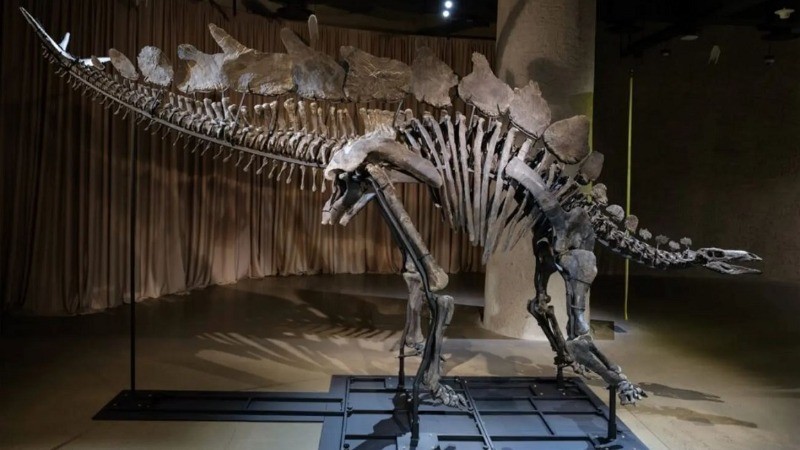
A 150-million-year-old Stegosaurus fossil, known as Apex, is now on display at the American Museum of Natural History in Manhattan. Purchased earlier this year for a record $44.6 million by billionaire Kenneth C. Griffin, Apex is the most expensive dinosaur fossil ever sold. Griffin has loaned the fossil to the museum for public viewing over the next four years. After that, a detailed cast will take its place.
Apex was revealed to a select group of reporters, photographers, and museum staff ahead of its official public debut on Sunday, December 8. The fossil stands 11 feet tall and measures 27 feet long. It is one of the best-preserved and nearly complete Stegosaurus fossils ever found, offering a rare look into the Jurassic period.
Sean M. Decatur, president of the museum, expressed his excitement about the exhibit. “This is one of the dinosaurs that everyone knows how to draw. It’s a unique chance to showcase a specimen that resonates with the public and also provides invaluable research opportunities,” Decatur said.
Kenneth C. Griffin, who is also the CEO of Citadel, highlighted the importance of sharing this extraordinary find with the public. “Apex offers a unique window into our planet’s distant past. I’m grateful that millions of visitors and researchers will have the chance to learn from this magnificent specimen,” Griffin said. He added that the joy children experience when drawing a Stegosaurus will now come to life for those who see the fossil in person.
Apex was discovered in 2022 by paleontologist Jason Cooper on his private land in Colorado. The fossil’s condition and near-completeness surprised scientists, making it a highly sought-after find in the field of paleontology. Originally expected to sell for around $6 million, the fossil drew intense interest from six bidders, driving the final price up to $44.6 million. This sale shattered the previous record for a dinosaur fossil, which was held by the Tyrannosaurus rex named Stan, sold for $31.8 million in 2020.
The Stegosaurus is one of the most well-known dinosaurs due to its distinctive features, including a row of large, kite-shaped plates along its back and a spiked tail, often called a “thagomizer.” This herbivorous dinosaur lived during the late Jurassic period, about 155–150 million years ago. It grew to about 30 feet in length and weighed between two and three metric tons. Despite its fearsome appearance, the Stegosaurus was smaller than many other dinosaurs of its time.
Kenneth Griffin’s passion for paleontology is not new. In 2017, he donated $16.5 million to Chicago’s Field Museum to fund an exhibit for Sue, the largest Tyrannosaurus rex skeleton ever discovered. Griffin’s support for these historic specimens ensures that they remain accessible to the public, sparking interest and promoting scientific research.
Apex’s arrival at the museum is a significant event in both science and public fascination. Visitors now have the rare opportunity to see one of the best-preserved Stegosaurus fossils ever discovered, bridging the gap between childhood imagination and scientific knowledge.
As Apex takes its place in the museum, it serves as a lasting symbol of the Earth’s ancient past and the ongoing efforts to understand and preserve our natural history for future generations.